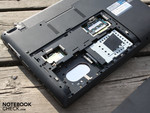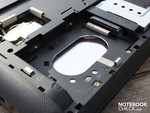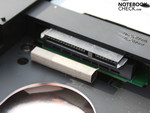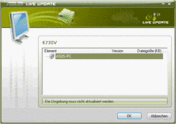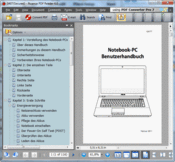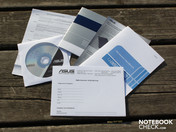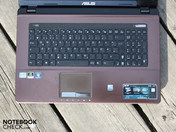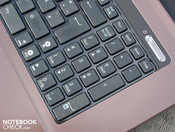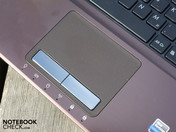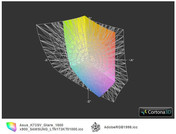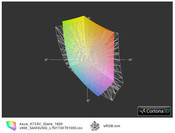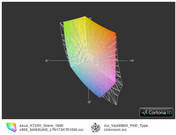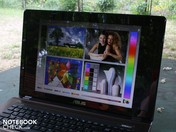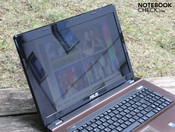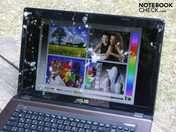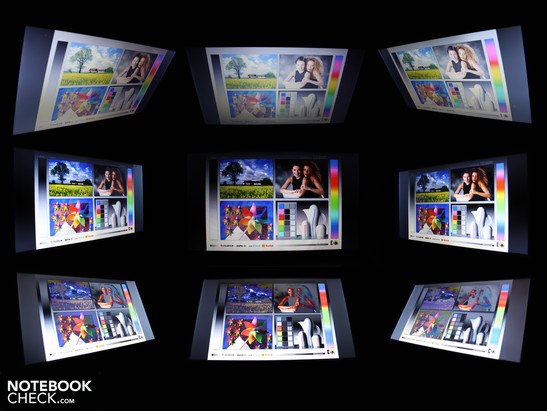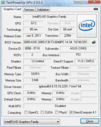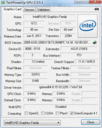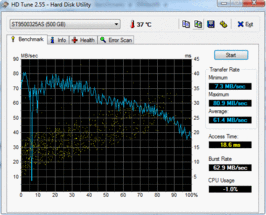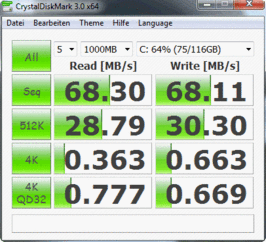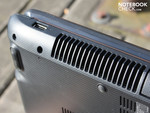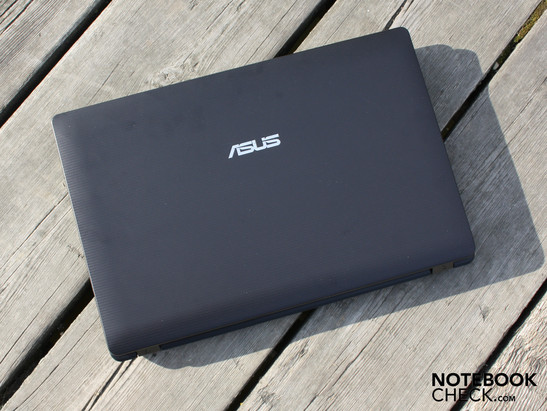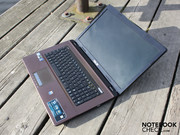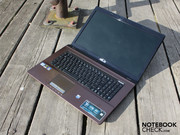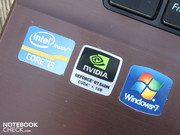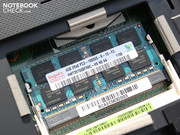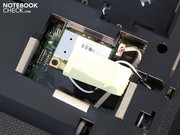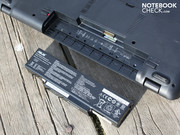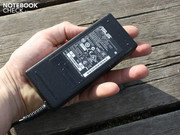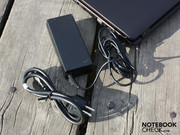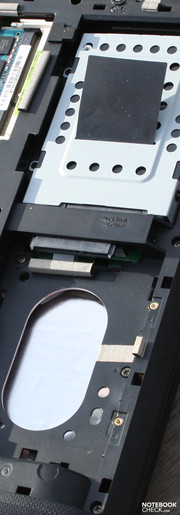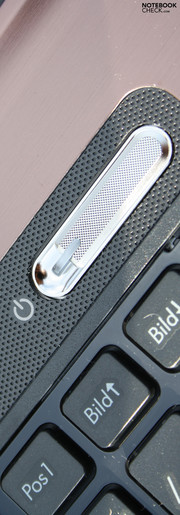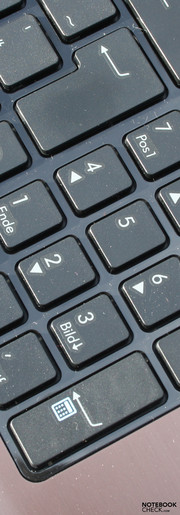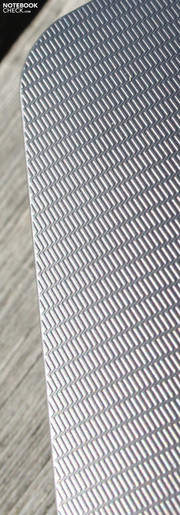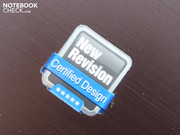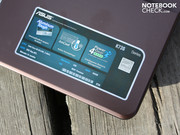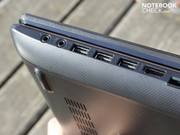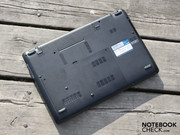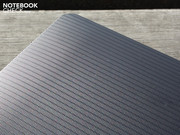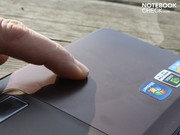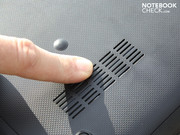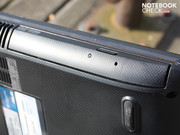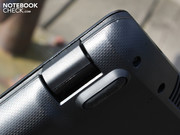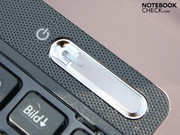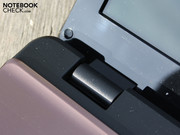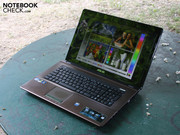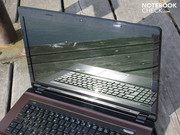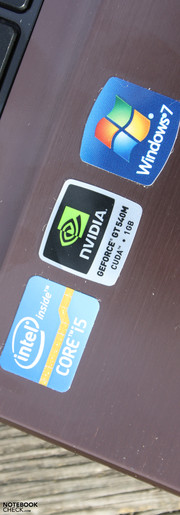Review Asus K73SV-TY032V Notebook

The manufacturer, Asus, particularly emphasizes following features on the product site of its K73SV: The IceCool technology allegedly keeps the wrist-rest cool by placing heat producing components in a perfect position. The second feature is the aluminum work surface that is supposed to be resistant against damaging. It also gives the 17 incher a quality, metallic look.
The technical specifications, consisting of an Intel Core i5 2410M (2.3 GHz) and NVIDIA GeForce GT 540M, correspond to the simultaneously reviewed premium 17 inch N73SV. The GT 540M promises good gaming performance, the i5 2410M should supply a midrange work speed with the 500 GB hard disk.
Find out in this review, where quality stops at a price starting of 745 euros. Is the WXGA++ screen from the same poor quality as in the N73SV? Is IceCool a gag or a real advantage? All answers in this review.
Case
The K73SV can be described as a plain looking laptop with quality materials. The lid is adorned by a stamped in and palpable pattern. This provides a pleasant grip and resistance against fingerprints, as well as scratching ring fingers. The same applies to the metallic and cool work surface made of brushed aluminum. It is resistant against scratches and lets fingerprints almost disappear.
The bulky case is very stable. We like the unyielding area above and beneath the DVD drive. We can hardly twist the case when we handle it with both hands. The wrist-rest can't be depressed anywhere, not even with force.
However, the lid is pliable. We can twist it by a few degrees without effort. But not anymore. Pressure on the lid's center area generates a clear dent with little force, but not any pressure marks on the front.
The hinges keep the lid tight in place and they don't allow teetering. The maximum opening angle is large: approximately 160 degrees. The high weight of 3385 grams contributes to the robust looks.
The base plate, made of simple plastic, doesn't dent anywhere. A larger maintenance cover leads us to the hard disks (2x HDD, optional), the main memory (2 slots, 1x 4GB inserted) and the WLAN module.
Connectivity
Interfaces aren't the K73SV's strength. The four USB ports are enough for printer, mouse or external hard disk. eSATA, USB 3.0 or ExpressCard34/54 (expansion cards) aren't available. The buyer has to opt for Asus' N series for a USB 3.0 option.
Right-handed users might find themselves on collision course with the USB, as well as HDMI or VGA cables when using a mouse. Ports placed in the left and right side's rear would prevent a cable mess on the desk (right). But this way, the right USB port is only practical for connecting memory sticks. The desk would massively be cluttered by cables with anything else. Rear-positioned interfaces unfortunately usually belong to a dream in multimedia notebooks.
Communication
The Atheros AR9002WB-1NG supports WLAN in the latest draft n standard. In order to use the high bandwidth of this standard, you naturally need a draft n router. There is also a Bluetooth module (3.0 +HS) installed. If you want to link the K73SV up with the gigabit switch at home, there is a corresponding LAN card, AR8151 PCI-E Gigabit Adapter, for this.
Supplies
There are no recovery data carriers included for Windows 7 Home Premium (64bit). Buyers should therefore burn an according DVD with the AI Recovery Burner. The built-in webcam is weak. It can only take pictures in 640x480 pixels (VGA). Image noises and streaks are quite intense.
Warranty
Asus bids a 24 month warranty with pick up & return service (1 year on battery). A warranty extension from two up to three years is available for 80 euros. The warranty extension has to be activated within 90 days.
Input Devices
Keyboard
The somewhat slippery keys fit tight on the surface (except for outer left), even over the DVD drive. The keys have a firm stroke, a clear pressure point and a medium key drop. The fingers type a bit disorientated corresponding to the smooth keys (without a conic concavity). The typing feel is all right due to the crisp pressure point.
The keyboard is generous, in regard to the gaps (4 millimeters). The minimized keys, including the crowded arrow keys, could prove to be annoying – in particular with large hands. Prolific typists could however get used to the keyboard.
Touchpad
The mouse replacement is slightly submerged into the wrist-rest. The pad is made of a hard, smooth plastic, which is unfortunately a bit dull in use. The surface is touch-sensitive up to its edges. The Elan SmartPad doesn't have any vertical or horizontal scroll bar (one finger use). It also can't be enabled in the software (v5.1). The user can alternatively scroll vertically and horizontally with two fingers (multi-touch).
The keys click fairly quietly, but have a very short key drop and pressure point. Consequently, the silver keys having a very poor feedback when they are clicked.
Display
The 17.3 inch screen is a representative of the low cost standard typical for the market. The screen (Samsung LTN173KT01000) has a resolution of 1600x900 pixels (WXGA++; 16:9). The high resolution contributes to the overview; lower resolutions would be to coarse for a 17.3 incher.
The screen has its weakness in the very small contrast of 164:1. The glare-type screen pretties up the contrasts optically, though. Thus, a crisp color impression is visually implied. However, the screen isn't suitable for professional picture editors since the color spectrum doesn't even cover sRGB (t). Moreover, the screen isn't AR coated. We have placed the good consumer display of the Vaio beside it for comparison (picture 3).
| |||||||||||||||||||||||||
Brightness Distribution: 87 %
Center on Battery: 225 cd/m²
Contrast: 164:1 (Black: 1.37 cd/m²)
57% AdobeRGB 1998 (Argyll 3D)
76.9% sRGB (Argyll 3D)
55.5% Display P3 (Argyll 3D)
The brightness assessment shows acceptable results. The luminosity has an average of 212 cd/m2. Our Gossen Mavo Monitor measures up to 225 cd/m2 selectively. The illumination is quite even with 87 percent. Is the brightness high enough to work in daylight despite the glare type screen?
If you set up the K73SV in the sun and want to play a round of Battlefield, you should look around for a shady place to avoid reflections. Our pictures were partly taken in the shade and maximum brightness. The result is quite viable since the 17.3 incher maintains its brightness in battery mode. Nevertheless, reflections could get annoying depending on light incidence.
The Samsung display corresponds to the majority of laptop screens (TN) in terms of viewing angles. The horizontal viewing angles are poor. We can only recognize unaffected colors up to a deviation of about 50 degrees from the front. Beyond that, an intense inverting develops. The colors already invert at 15 degrees when looking down or up onto the screen (vertically).
Performance
The brand new Sandy Bridge CPU, i5-2410M (2x2.3 GHz) has a turbo rate of 2.9 GHz (single core). The CPU can, depending on the temperature, also clock beyond that within the range of Turbo 2.0. That is provided the cooling has enough reserves. The CPU calculated consistently with 4x2.693 MHz in our tests (2 virtual HT cores).
The graphics chip, HD Graphics 3000, is incorporated in the processor (650 – 1100 MHz). Nvidia Optimus in connection with the Geforce GT 540M makes it possible. One of the two HDD slots is equipped with a Seagate ST9500325AS (500GB 5400 rpm). One of two RAM slots is empty and a 4096 MB PC3-10600S module is inserted into the other.
Is the i5-2410M (2x2.3 GHz) sufficient, or should you better look around for a Core i7 2720QM (4x2.2 GHz)? The 2410M achieves 3682 points when calculating with one core. A 2720QM would achieve 4138 points (Cinebench R10 Single 32 bit). The quad core only has a small advantage (+11%).
The same picture in Cinebench R10 Multi 32 bit. The i5-2410M (4 threads) scores 9659 points. A 2720QM (8 threads) achieves 14272 points (+38%). The former mentioned single core calculations are hardly ever an issue in routine work. If you benefit from multi thread computing power (e.g. video rendering, picture editing), you are better served with the Sandy Bridge quad core. Asus however doesn't sell any K73 version with a quad core. The buyer would have to change to the N series.
| PCMark Vantage Result | 5734 points | |
Help | ||
PCMark Vantage finishes with 5734 points. This is a poor result in comparison to new Sandy Bridge laptops. For example, the Dell XPS 15-L502x achieves 6442 points with the same CPU. The reason: a faster rotating HDD of 7200 rpm. SSD systems, such as the XMG A701 Advanced, can even achieve 14000 points in this benchmark. Apart from that, quad core alternatives, such as the Asus N53SV (HDD, i7-2720QM) are positioned at 8548 points.
| 3DMark 03 Standard | 20210 points | |
| 3DMark 05 Standard | 15560 points | |
| 3DMark 06 Standard Score | 7861 points | |
| 3DMark Vantage P Result | 4147 points | |
| 3DMark 11 Performance | 979 points | |
Help | ||
The rotating hard disk provides rather weak data throughputs. The hard disk (500 GB) from Seagate reads with 61 MB/s in sequential read (HD Tune). CrystalDiskMark shows a somewhat better 68 MB/s in read and write. PCMark Vantage's HDD sub score is 3370 points. First faster 7200 rpm hard disks achieve 3500 to 4000 points. SSDs reach up to 25000 (!) points in the HDD sub score.
The GeForce GT 540M (1024 MB DDR3) belongs to the upper graphics midrange. It supports DirectX11 and GDDR5 memories. However, a 1024 MB DDR3 video memory is soldered into the device as usual. As a feature of the Asus barebone, it clocks with 900 MHz (core). Acer, for example, relies on 800 MHz (Aspire).
Risen
The graphically detailed adventure from 2009 can no longer be played consistently smooth in high details. We aren't even talking about the native resolution (1600x900) in this case, but about 1366x768. In any event, medium details have to be selected.
Battlefield: Bad Company 2
The action shooter from the beginning of 2010 proves to be less demanding than the older Risen. High resolutions and details are possible, whereas the GT 540M again can't manage the native resolution smoothly.
| Risen | |||
| Resolution | Settings | Value | |
| 1366x768 | all on/high, 4xAF | 25 fps | |
| 1024x768 | all on/med, 2xAF | 39 fps | |
| Battlefield: Bad Company 2 | |||
| Resolution | Settings | Value | |
| 1366x768 | high, HBAO on, 1xAA, 4xAF | 32 fps | |
| 1366x768 | medium, HBAO off, 1xAA, 1xAF | 44 fps | |
Gaming Verdict
The world of games can be entered with the Geforce GT 540M (@900MHz). Provided that the native 1600x900 pixels aren't used, most games can be played in medium to high details (up to 1366x768). However, if you're always out for the newest games and aren't satisfied with medium details, you should look around for an alternative with a GeForce GT 445M/GT 555M or Radeon HD 5850/HD 6850.
| low | med. | high | ultra | |
|---|---|---|---|---|
| Risen (2009) | 39 | 25 | ||
| Battlefield: Bad Company 2 (2010) | 44 | 32 |
Emissions
System Noise
Asus' 17 incher shows itself from its best side in terms of noise. The fan is never inactive in idle, but it rotates almost silently at its lowest speed. We measure 32 dB(A) in idle mode. The noise that our noise meter detects doesn't come from the fan, but rather form the hard disk. Its level of 32.1 dB(A) is never louder than the fan, not even when it starts to click quietly.
As expected, the fan whirs more evidently during CPU load or games. However, it doesn't go beyond 34 dB(A) during a computer game or 3DMark2006. The fan first turns up to an audible 37 dB(A) in the stress test (Furmark & Prime95). But you can't say it's noisy. A constant CPU stress test (Prime95) lets the fan whir along with 34.3 dB(A). The fan always rotates in both idle and during constant load steadily.
Noise level
| Idle |
| 31.8 / 32.1 / 32.3 dB(A) |
| HDD |
| 32.1 dB(A) |
| DVD |
| 33.9 / dB(A) |
| Load |
| 33.9 / 37 dB(A) |
 | ||
30 dB silent 40 dB(A) audible 50 dB(A) loud |
||
min: | ||
Temperature
The bottom's average temperature is 25 degrees Celsius in idle. The wrist-rest areas are cool with 25 degrees. The picture only changes marginally in sporadic office applications.
The waste heat during stress only changes the blue graph at few points. The average stays almost unchanged at the top and bottom. On the top, the thermometer records 34 degrees selectively during maximum load. The wrist-rest doesn't heat up beyond 26 degrees. The waste heat is at most noticed in the fan's vicinity on the bottom. While we measure lukewarm 37 degrees there, the area underneath the wrist-rest stays cool with 25 degrees.
(+) The maximum temperature on the upper side is 33.8 °C / 93 F, compared to the average of 36.9 °C / 98 F, ranging from 21.1 to 71 °C for the class Multimedia.
(+) The bottom heats up to a maximum of 37 °C / 99 F, compared to the average of 39.2 °C / 103 F
(+) In idle usage, the average temperature for the upper side is 25.5 °C / 78 F, compared to the device average of 31.3 °C / 88 F.
(+) The palmrests and touchpad are cooler than skin temperature with a maximum of 26 °C / 78.8 F and are therefore cool to the touch.
(+) The average temperature of the palmrest area of similar devices was 28.7 °C / 83.7 F (+2.7 °C / 4.9 F).
Speakers
Both stereo speakers are located above the keyboard beside the Altec Lansing logo. A gaming suitable laptop should have a good sound so that users are equipped for movies, games or music. Asus doesn't build in a subwoofer. The sound emphasizes the midranges intensely, while high ranges and low pitches are neglected. Consequently, the sound makes an undifferentiated and frayed impression.
The volume is adequate for a 17 incher, There is no scratching at the maximum. External headphones can be connected via the headphone out or the optical SPDIF. The sound can also be transmitted digitally via HDMI in combination with a television.
Battery Life
17 inchers also have the chance of good battery runtimes since the Arrandale/Sandy Bridge CPU generation. The manufactures don't even have to invest in expensive 9 cell battery packs. The usual 56 watt hours (5200 mAh) batteries like used in 15.6 inchers suffice, as in the Asus K73SV.
The K73 SV achieves very good 4:46 hours in the WLAN test. The 17.3 inchers can stand in the office for a whole 6:47 hours in idle. You can manage easily with 3:29 hours if you insert DVD movies on the go. We remember the Asus N73JQ with a quad core CPU that was drained after only two hours in the WLAN test.
The low power consumption of 16 watts in idle (idle minimum) confirms the good office runtimes. The multimeter climbs to 21.9 watts in high performance mode (wireless on, maximum brightness). In comparison: Asus N73JQ-TZ087V (740 QM) – 19.3 to 29.5 watts.
The K73SV proves to be fairly greedy in the CPU and GPU stress test (Prime95, Furmark) with 77 watts. 63 watts are consumed when only the GT 540M is calculating (Furmark; @3DMark2006: 60 watts). Thus, the 90 watt adapter is adequately sized. The power adapter's temperature didn't exceed 50 degrees even after the stress test of several hours.
| Off / Standby | |
| Idle | |
| Load |
|
Key:
min: | |
Verdict
The Asus K73SV, version TY032V (from 745 Euro) fuses many advantages with just as many drawbacks. Consequently, the rating is remote from a very good but better than a satisfactory.
The stable case with the aluminum work surface and lid's matt haptics make a work suitable impression. The reflective WXGA++ screen spoils working on pictures and the enjoyment of contents with a low contrast and narrow viewing angles. A higher quality screen could have improved the total impression considerably, especially for the purpose as home studio or entertainment machine.
The input devices might not deter undemanding office workers, but in particular the stiff touchpad keys are unfavorable. As to the interfaces, the second HDD slot (upgrading, not RAID) is a highlight. Asus however saves on USB 3.0, just as on rear-placed ports or an ExpressCard34 for expansions.
The battery life of 3:30 to 4:30 hours is, alike the gaming performance, on a moderate level. The latest games can't be played natively with 1600x900 pixels, but in return in medium to high resolutions up to 1366x768 pixels.
The promise of low emissions didn't turn out to be a gag. We couldn't tease deafening noise out of the K73SV even during maximum load. The fan is only just audible during games. The IceCool wrist-rest keeps its promise and never gets warmer than 26 degrees (hardly changes between load/idle).




